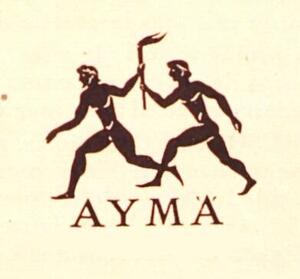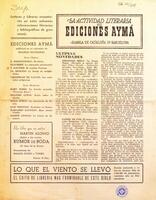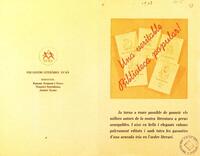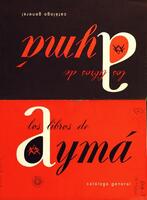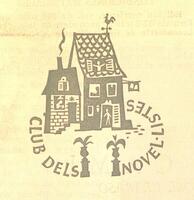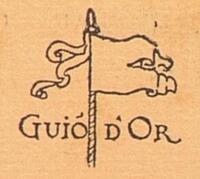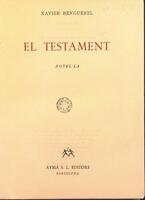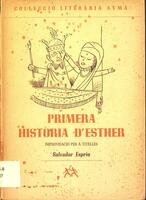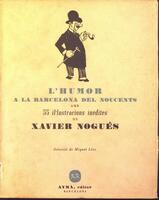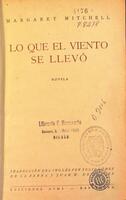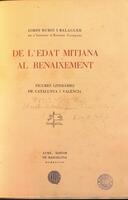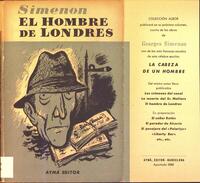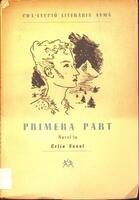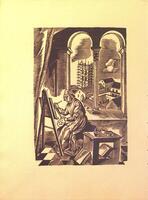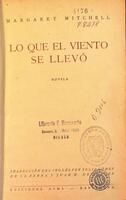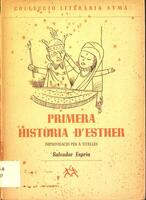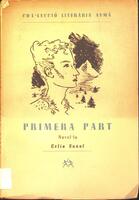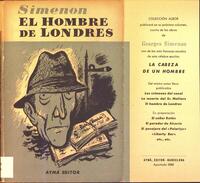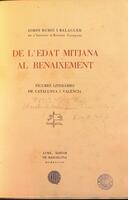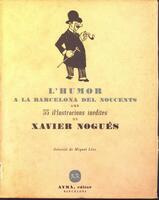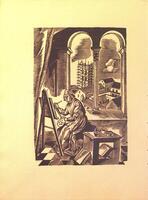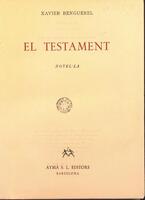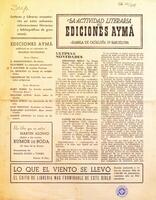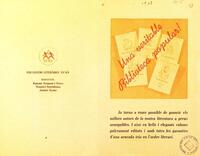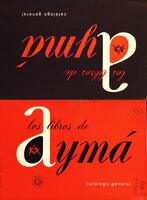Aymà
(Updated 08/10/2024)
In 1942, Jaume Aymà i Ayala and Jaume Aymà Mayol, father and son, respectively, founded Ediciones Aymá, a name that would undergo several changes over the years. The imprint published translated works of fiction – obligatorily only in Spanish – by renowned authors (Rainer Maria Rilke, Pearl S. Buck, G. K. Chesterton, etc.) as well as a large number of works by Georges Simenon. In those early years, the publication of Margaret Mitchell’s Lo que el viento se llevó (Gone with the Wind) was a resounding success, as thousands of copies were sold out within days. They also created several collections with the city of Barcelona as the main theme.
In the 1940s as well, in addition to being a publishing house, Aymà also issued some underground books in Catalan, alternating the printer’s mark (L’aperitiu by Josep M. de Sagarra appears as having falsely been published before the Civil War and printed in Perpignan). The imprint was able to launch the Col·lecció Literària Aymà with works in Catalan in 1946, albeit with many restrictions.
+ informationSearch collections
Jaume Aymà Mayol collection at the Arxiu Nacional de Catalunya (National Archive of Catalonia)
Jaume Aymà Mayol collection at the (Institut d’Estudis Catalans) Institute of Catalan Studies
Catalogue of publishers and booksellers from the Bergnes de las Casas collection (Biblioteca de Catalunya)
Catalogue of publishers of Catalonia from 1940 to 1975 (Biblioteca de Catalunya)
More information and documentation on the works produced
Aymà, Jordi. “Jaume Aymà i Mayol, editor”, Anuari TRILCAT, 1 (2011), p. 163-173.
Llanas, Manuel. L'Edició a Catalunya. Segle XX (1939-1975). Barcelona: Gremi d'Editors de Catalunya, 2005.
Samsó, Joan. La cultura catalana entre la clandestinitat i la represa pública. [Barcelona: Abadia de Montserrat, 1994-1995. Vol 2.
Aymà
Description
In 1942, Jaume Aymà i Ayala and Jaume Aymà Mayol, father and son, respectively, founded Ediciones Aymá, a name that would undergo several changes over the years. The imprint published translated works of fiction – obligatorily only in Spanish – by renowned authors (Rainer Maria Rilke, Pearl S. Buck, G. K. Chesterton, etc.) as well as a large number of works by Georges Simenon. In those early years, the publication of Margaret Mitchell’s Lo que el viento se llevó (Gone with the Wind) was a resounding success, as thousands of copies were sold out within days. They also created several collections with the city of Barcelona as the main theme.
In the 1940s as well, in addition to being a publishing house, Aymà also issued some underground books in Catalan, alternating the printer’s mark (L’aperitiu by Josep M. de Sagarra appears as having falsely been published before the Civil War and printed in Perpignan). The imprint was able to launch the Col·lecció Literària Aymà with works in Catalan in 1946, albeit with many restrictions.
In 1947, the Joanot Martorell Novel Prize was launched, initially by Aymá alone and later in conjunction with the Selecta publishing house.
During the 1950s, it published major works, including the first important works in Catalan since the end of the Civil War such as Les terres catalanes by Pere Blasi, L’art català, overseen by Joaquim Folch i Torres, and Les tradicions catalanes, overseen by Agustí Duran i Sanpere.
Children’s and young reader literature also had a place in the Aymà catalogue, as it published a collection of small and large-format books with Jean de Brunhoff’s character of Babar, some of them translated by Carles Riba. It also published illustrated albums with the biblical stories for children by Henri Daniel-Rops. For young readers, Aymà published adventure books like Robert Louis Stevenson’s La isla del tesoro (Treasure Island) and Daniel Dafoe’s Aventuras de Robinson Crusoe (The Adventures of Robison Crusoe).
Jaume Aymà i Ayala left the publishing house in 1962, as did his son in 1963, the year when the businessman and cultural promoter, Joan Baptista Cendrós, gained control of the publishing house and incorporated the publishing collection of Proa and Alcides and the collections Els llibres de l’óssa menor and Quaderns de teatre A.D.B. The Aymàs went on to found the small publishing house, Delos-Aymà, whose collection in the end was passed to Editorial Andorra.
The names of Jaume Amyà I Ayala and Jaume Aymà Mayol will forever be associated with the post-war recovery of Catalan literature.
Aymà
Authors
Aymà published both new, unpublished authors and authors from the past, both local and international, in Spanish, and in Catalan when allowed, although in addition to the publishing house Aymà issued some underground works in Catalan with false printer’s marks.
Amades, Joan, 1890-1959
Benguerel, Xavier, 1905-1990
Bonet, Blai, 1926-1997
Duran i Sanpere, Agustí, 1887-1975
Espinàs, Josep M., 1927-2023
Espriu, Salvador, 1913-1985
Oliver, Joan (Pere Quart), 1899-1986
Oller, Narcís, 1846-1930
Rubió i Balaguer, Jordi, 1887-1982
Sales, Joan, 1912-1983
Simenon, Georges, 1903-1989
Suñol, Cèlia, 1899-1986
Aymà
Illustrators and photographers
Using a pseudonym, Ricard Giralt-Miracle illustrated the covers of the Aymà collection devoted to the works of George Simenon. The publishing house’s children’s catalogue includes Jean de Brunhoff’s drawings of his elephant Babar. Josep Narro illustrated the books in the Guió d’Or collection.
Aymà
Collections
The Col·lecció Literària Aymà, Dafne and El Club dels Novel·listes were three of Aymà’s most important collections of fiction in Catalan. Órbita and La Bahía were two of the most important collections it published in Spanish. The Grandes Novelistas Modernos collection contained what became its biggest commercial success, Lo que el viento se llevó (Gone with the Wind). It devoted its Barcelona, Divulgación Histórica and Barcelona Histórica y Monumental collections to the city of Barcelona, and the Guió d’Or collection to collectors’ editions. Children’s books were issued through the collection of small and large-format books devoted to the famous character of the elephant Babar and in the series of children’s books with biblical topics by Henri Daniel-Rops. Crime novels had a collection devoted exclusively to Georges Simenon, which included a series for the works featuring detective Maigret. The Voz Imagen collection was reserved for the worlds of the theatre and cinema.
Aymà
Outstanding works
Aymà published a wide range of books by classic authors, along with previously unpublished authors and a variety of topics such as books on art, history, religion and literature, along with collectors’ editions, travel books, crime novels and children’s albums.
-
Lo que el viento se llevó (Gone with the Wind), one of Aymà’s early successes, it was the top-selling work. In just a few days, 12,000 copies were sold out and the publisher ultimately sold hundreds of thousands of copies. Curiously, the novel passed the censors even though the film was banned; it did not premiere in Spain until 1950.
Mitchell, Margaret. Lo que el viento se llevó: novela. Barcelona: Aymà, 1943.
-
Primera història d’Esther by Salvador Espriu was one of the most prominent titles from the Col·lecció Literària Aymà collection, while it was also one of the seminal works of Catalan post-war literature.
Espriu, Salvador. Primera història d’Esther: improvisació per a titelles. Barcelona: Aymà, 1948.
-
With Primera part, in 1947 Cèlia Suñol won the first of the Joanot Martorell prizes, which were originally awarded by the Amyà publishing house. en origen, per l’editorial Aymà. The work was published within the Col·lecció Literària Aymà collection.
Suñol, Cèlia. Primera part: novel·la. Barcelona: Aymà, 1948.
-
In 1948, Aymà published the first title in a collection devoted exclusively to the Belgian author, Georges Simenon. The editor Ferran Canyameres transferred the translation and publication rights to the publishing house, which issued the novels as part of the Albor collection, within which it created a series devoted to the famous detective Maigret, called Maigret en Acción. Ricard Giralt-Miracle illustrated the covers, which he had to sign with the pseudonym M. Tlarig (his name written backwards) because of his disqualification after the Civil War.
Simenon, Georges. El hombre de Londres. Barcelona: Aymà, 1948.
-
Guió d’Or was the collection of studies on historical and literary matters that Aymà targeted at a select, restricted group of readers.
Rubió i Balaguer, Jordi. De l’edat mitjana al Renaixement: figures literàries de Catalunya i València. Barcelona: Aymà, 1948.
-
L’humor a la Barcelona del Noucents contains texts by essential authors in Catalan literature such as Prudenci Bertrana, Pere Calders, Josep Carner, Pere Quart and Santiago Rusiñol, all of them with original illustrations by Xavier Nogués.
L’humor a la Barcelona del Noucents. Barcelona: Aymà, 1949.
-
Illustration by Josep Narro extracted from one of the goods from Aymà’s Guió d’Or collection, in which Giralt-Miracle is also listed as the illustrator.
Verrié, Frederic-Pau. La vida de l’artista medieval. Barcelona: Aymà, 1953.
-
El testament by Xavier Benguerel opened the El Club dels Novel·listes collection which also published Joan Sales’ Incerta glòria, a novel that won the Joanot Martorell Prize in 1955.
Benguerel, Xavier. El testament: novel·la. Barcelona: Aymà, 1955.
- The publishing house’s newsletter from 1943, featuring the novel Lo que el viento se llevó (Gone with the Wind), its bestselling book published in the Col·lecció Literària Aymà collection in 1948.
- Covers of one of the publishing house’s catalogues from 1958, illustrated by Ricard Giralt-Miracle.
